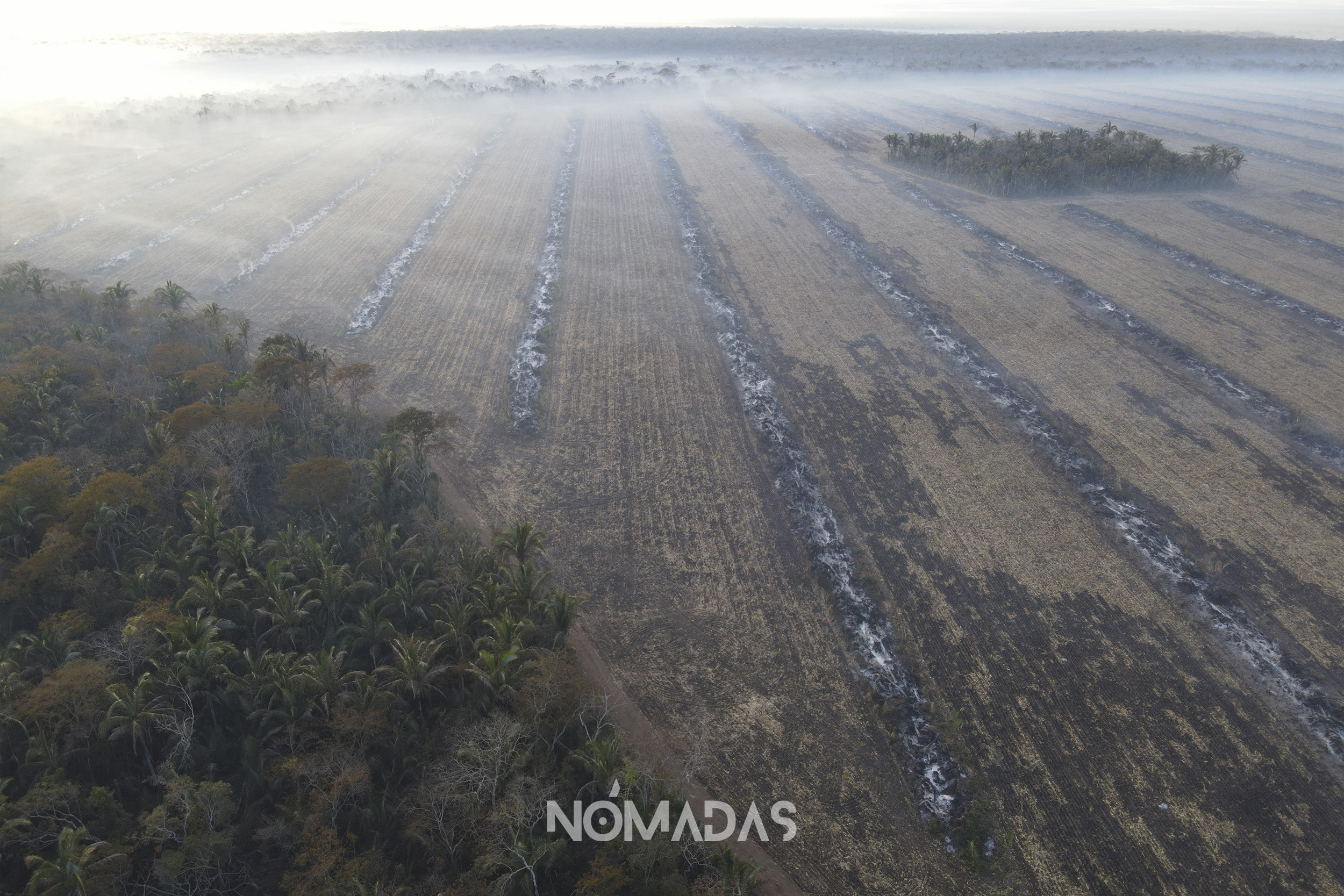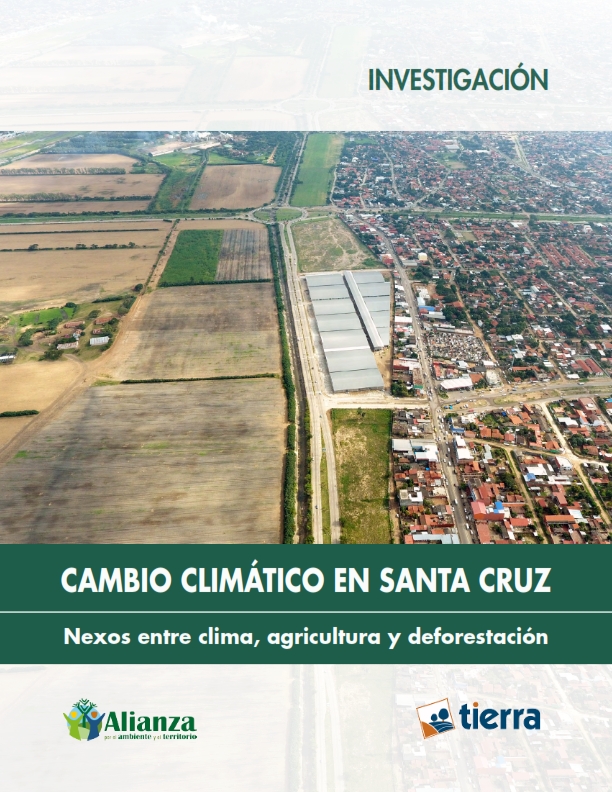ENGLISH


ENGLISH

With the felling of trees, many environmental benefits are lost.
September 9th, 2023
The research by Fundación TIERRA reveals that climate change in the Santa Cruz region is both a consequence and, at the same time, a cause of the accelerated and uncontrolled expansion of agriculture and deforestation. Over the past 40 years, global warming has increased the world’s temperature by 0.6°C, yet Santa Cruz has experienced a rise of 1.1°C. Additionally, rainfall in the area has decreased by 27% compared to four decades ago.

Roberto Navia Gabriel
Journalist
This forest is no longer a forest. It’s the tip of hell. What was once the epicenter of biodiversity and the harmony of nature has turned into a gloomy scene. The logs lying haphazardly, like bodies fallen at the edge of a precipice. Where wild animals used to dance among the thickets, now only the metallic scream of silence remains. The birds, masters of song, have embarked on a forced exodus. The river over there, once a constant companion of the jungle, flows alone, under the desolate gaze of the sun, and its waters reflect a sky that is no longer the same.
Here, it’s so hot that the suffocating temperature doesn’t seem from this world. Or at least, not from the world that existed here before the unbridled appetite of deforestation arrived with all its might to bring everything down.
This is San Ignacio de Velasco, the epicenter of the Chiquitano Dry Forest, in Santa Cruz, Bolivia: a unique ecosystem on the planet, but also one of the places where the green lungs fall to clear the horizon for soy and pastures that feed livestock and fuel speculation and land trafficking in Bolivia.
Where wild animals once danced among the shrubs, now only the metallic cry of silence remains.
But San Ignacio is not the only site of environmental apocalypse in the South American country. It’s merely the tip of a ball of yarn rolling within other battered vegetation. San Ignacio is the faithful mirror of what’s happening in Pailón and Concepción, in San José de Chiquitos and Charagua, which all together account for 41% of the deforested forests in the Santa Cruz department.
This is not only the place of fallen trees. It’s where high temperatures are born that travel to the rest of the Santa Cruz department, carrying a hefty toll: over the years, the inhabitants of this region have observed how the heat has become more stifling, how several lagoons have dried up, how wild animals have begun to disappear, and how rain is becoming a scarce commodity.
For all this combination of manifestations that nature is revealing, there are explanations that confirm that all the woes the planet is suffering, and Santa Cruz in particular, are solely due to the infamous Climate Change.
Human actions against the forests of Santa Cruz carry a great deal of blame.
This is reflected by Fundación TIERRA, which has just published the research: Climate Change in Santa Cruz, Connections between Climate, Agriculture, and Deforestation. This publication addresses the issue of climate change in the Santa Cruz department and its interdependencies with agriculture and deforestation. From a multidisciplinary perspective, it identifies and evaluates the transformations of the last four decades (1981-2020) and projections until the year 2060.
This work, published in a 146-page book made possible with the support of the Swedish Agency for International Development (ASDI) and the Alliance for Environmental and Territorial Rights of Indigenous Peoples of Bolivia, formed by Fundación TIERRA and CEJIS, reveals that climate change in the soil of Santa Cruz is both a consequence and, at the same time, a cause of the accelerated and uncontrolled expansion of agriculture and deforestation.
Although global climate change impacts negatively, the research by Fundación TIERRA, led and developed by Gonzalo Colque, José Luis Eyzaguirre, and Efraín Tinta, has discovered that it’s not the only nor the main cause of Santa Cruz’s climate problem: climate, agriculture, and deforestation are closely interconnected.

The results are alarming:
Over the past 40 years, global warming has increased the planet’s temperature by 0.6°C. However, Santa Cruz has experienced an increase of 1.1°C, from an annual average of 24.7°C to 25.8°C. This figure represents an 83% increase compared to planetary behavior, indicating that Santa Cruz is experiencing a much more accelerated pace in temperature increase compared to the rest of the world.
The concerned voice of Gonzalo Colque, researcher and member of Fundación TIERRA, accompanies the magnitude of the revelation because he knows that every piece of data in the book and now at the tip of his tongue is meant to raise the alarm about what is happening and how life is projected for the coming years:
«Every decade, the average temperature of this region of Bolivia increases between 0.3 and 0.4°C, suggesting that, in the worst-case scenario, Santa Cruz could reach a warming of 3.2°C by the year 2060,» says Colque, who knows that these seemingly small data points are not insignificant.
For the indigenous people of lowlands, whose lives have been intricately tied to the land and its cycles, the 1.1°C increase has triggered a cascade of unforeseen changes. Crops that used to flourish without problems now face unexpected droughts, and water availability becomes increasingly uncertain.
In the bustling heart of the city of Santa Cruz, this increase affects the daily lives of its inhabitants, and now, with this data, it’s demonstrated that what happens in the forests doesn’t stay in the forests. If it’s taken care of, the jungle will return that care by sending rains and pure air to the urban areas. If it’s destroyed, droughts and high temperatures that are already here.
Beyond the urban limits, the Chiquitano forest surrounding the Santa Cruz region shudders under the influence of the temperature rise. The vegetation, adapted to long-standing climate patterns, struggles to maintain its balance amidst change. Biological diversity, from majestic jaguars to elusive tapirs, finds its habitat increasingly fragmented and challenging. Rivers, once sources of life and sustenance, diminish and are affected by more frequent droughts, impacting aquatic fauna and communities that depend on them.
The warming in Santa Cruz is not uniform throughout the department, points out Gonzalo Colque. He says that in the Central and Eastern zones, the situation is even more serious, as while the core zone’s temperature increased by 0.9°C, the agricultural expansion zone reached 1.2°C, a difference of 0.3°C between the two places.
The rain that used to fall generously over Santa Cruz has slowed down. Nowadays, there’s 27% less rainfall than four decades ago. Those old precipitations that once filled rivers and lagoons have decreased in intensity, dropping from 1,446 mm to 1,050 mm per year. This is affirmed by Gonzalo Colque, who holds the research in his hands.
Every decade, the average temperature in this region of Bolivia increases by 0.3 to 0.4°C.
This downward trend is being accompanied by extreme climatic events that disrupt the days and nights of wild animals and humans living not only in rural areas but also in intermediate populations and in the city of Santa Cruz. There, sudden floods have been recorded as a consequence of torrential rains in just a few days, along with prolonged droughts due to the absence of rainfall. Although climate scientists struggle to decipher the patterns of these erratic phenomena, the general perception among the population is that they occur more frequently now.
Dalila Bejarano, a resident of the San Francisco community within the San Matías Integrated Natural Management Area (ANMI), laments that drought deepens every year, that the river that used to pass a hundred meters from her house is completely dry.
The clay pots in the houses of San Francisco, Palmeras, and other communities in the area are empty, waiting for the sky to open its floodgates as it did generously in the better years of the past when extensive agriculture didn’t yet have a free hand to do as it pleased in the department.
Gonzalo Colque reveals another fact: «In the core zone of Santa Cruz, rainfall has decreased by 26%, while in the agricultural frontier expansion zone, the reduction reaches 28%.»
This means that the Central and Eastern regions of Santa Cruz bear the burden of this decrease, and it’s the Chiquitania that suffers the leading role of being the most affected territory by the reduction of rainfall.
«All of this, all of that, and beyond that horizon, was full of water,» says Dirlene Mejía, a resident of the Chiquitano community of Motacucito, as her hands give life to her words, as if she were weaving memories in the air. In her gaze, there’s a silence that speaks volumes, a restrained cry that doesn’t dare to escape.
«Concepción Lagoon has dried up completely,» says Dirlene, walking among the tall grass that sometimes reaches her waist, as if she were searching for traces of a past time. Soon, she will reach lands that used to be a water mirror, depths that today are merely divided earth. Each step Dirlene takes is light, without obstacles to stop her feet, only the stifling heat that envelops her within minutes. Amidst that vastness, she finds refuge under a low bush. A bush that once stood on the shore but is now an oasis amidst the aridity.
The wind, like a loyal friend, caresses her warm skin, while the thirsty palm trees sway in their lost melody. The wind carries with it the history of floods, of times when the palm trees were part of a flooded landscape, a symphony that now seems like a distant echo.
The dry body of Concepción Lagoon lies in the geographic heart of the Bolivian department of Santa Cruz, within the Chiquitano Dry Forest, lying in the municipalities of Pailón and San José. Since 2002, it’s been a RAMSAR site, meaning an internationally significant wetland protected by an intergovernmental environmental treaty established in 1971 by UNESCO. Furthermore, in 2009, it was designated as a protected area and is currently known as the Natural Heritage Conservation Unit (UCPN) – Laguna Concepción Departmental Wildlife Refuge, spanning an area of 135,566 hectares.
But these accolades have meant nothing for Concepción Lagoon. When it comes to deforestation, the clear-cutters don’t pay attention to these details. At the edge of Concepción Lagoon, the Mennonite colony of California has not only cleared vegetation to make room for agriculture but has also constructed drainage channels that empty into the lifeless bed of the aquifer.
Just as confirmed now by Fundación TIERRA’s research, the reduction in rainfall has led to the decrease of various freshwater reservoirs, the deterioration of «curichis» and wetlands, alongside the disappearance of rivers and streams throughout the departmental territory. Water vulnerability is increasing rapidly with rising temperatures, evaporation, and more frequent forest fires.
The rhythm of the seasons, which has been a constant in the lives of Santa Cruz inhabitants for generations, is undergoing a dramatic change. The onset of the rainy season —that eagerly awaited time when nature dresses in green and fields come to life— is considerably delayed. The months that used to bring humidity and precipitation now bear witness to persistent heat and unusual drought.
The rain that used to fall generously over Santa Cruz has slowed down. Nowadays, it falls 27% less than four decades ago.
Alcides Vadillo, regional director of Fundación TIERRA, emphasizes that the transition between the dry season and the wet season is being altered. Based on the research, he confirms that the weeks and months that used to mark this period of change are expanding, shifting towards the end of the year. September, October, November, and even part of December are becoming the hottest and least rainy transition months of the year.
He knows that this delay in the arrival of rains not only affects the natural calendar but also has implications for the duration of the wet season. The early absence of rains shortens the time during which the land can absorb moisture and sustain life. As a result, the wet season becomes compressed, which can lead to extreme and erratic climatic events. When the rains finally arrive, they can be more intense and less predictable.
The change in rainfall patterns is not limited to Santa Cruz. The Bolivian Amazon and the southwestern region of the Brazilian Amazon are also experiencing this phenomenon. In this area, known as the South American Monsoon region (SAM), the South American Monsoon plays a crucial role. Alterations in this climatic pattern have a greater impact on Santa Cruz due to changes in land use and the intensity of winds across plains without natural barriers. The change in land use involves converting forested areas into intensive agricultural fields. As the soil is not suitable for crops, it degrades within a few years, and farmers advance into the remaining forest, repeating a development model that leads nowhere.
The echo of Gonzalo Colque’s words resonates with a stark warning: extreme heat, with its stifling embrace, is destined to become an increasingly recurrent visitor to the region. Colque, a renowned expert in environmental issues, presents a disquieting perspective for the years to come. His analysis projects a scorching future where thermometers will relentlessly rise above 40°C on average for 14 to 29 days per year by 2060.
The change goes beyond statistics and graphs; it’s a tangible promise of intense heat that challenges the limits of human tolerance and the adaptability of nature. The contrast is overwhelming: from just three current days with extreme temperatures, the threshold will unprecedentedly expand to a scenario of 14 to 29 days of sweltering heat annually. It’s a historic rupture that shakes the previously stable climatic foundations of the Santa Cruz region.
This thermal metamorphosis will not only mark a change in measurements but will also leave its mark on the geographical and human fabric of the region. New municipalities and settlements will witness scorching days, particularly in the Central and Eastern parts of the department, where days of extreme heat will impose themselves as a reality — a constant reminder that the effects of deforestation are not a distant theory but a palpable transformation that demands bold and urgent responses.
The vast expanses of land in Santa Cruz, which were once the domain of wild nature, have undergone a remarkable metamorphosis in recent decades. The agricultural sector has grown exponentially, shaping an agricultural model characterized by the expansion of crop fields, the presence of monocultures, and the massive export of harvests. In just 40 years, the growth of the agricultural sector is evident, going from 264,000 hectares annually in the 1980s to over 3 million hectares in 2022. This transformation has solidified an agricultural model that has left a profound mark on the region.
Extreme heat, with its suffocating embrace, is destined to become an increasingly recurrent visitor in the region.
Agriculture in Santa Cruz has stood out for its focus on large monoculture fields and intensive use of agricultural machinery. The landscapes of endless expanses of crops are emblematic of this model. Soybeans, in particular, have become the flagship oilseed of the region. Bolivia ranks among the top 10 global soybean producers, with Santa Cruz leading this production.
So much so that soybeans —according to the research of Fundación TIERRA— occupy half of the cultivated lands in the department. With an annual harvest exceeding 3.4 million tons, this crop has become an economic cornerstone of the region. The agricultural productivity of soybeans, reaching around 2.3 tons per hectare, significantly contributes to the production value. In 2022, with an average international price as a reference, the value of soybean production approaches $2 billion, representing about 15% of the departmental Gross Domestic Product (GDP).
Despite the achievements in the agricultural sector, significant concerns arise. Soil degradation is a topic that raises concerns. While there are no exhaustive studies on this phenomenon, the Ministry of Environment and Water estimates that between 2001 and 2020, around 400,000 hectares in Santa Cruz have suffered degradation, as confirmed by the research of Fundación TIERRA. This means that the total area of land intervened for agricultural purposes is much larger than the land actually cultivated each year.
The changing landscapes of Santa Cruz hold a silent yet powerful story of transformation. Over the past four decades, more than 7.5 million hectares of forests have been consumed by deforestation. Ecosystems that were once havens of biodiversity and natural majesty have yielded to human expansion and the quest for cultivable land. The magnitude of the transformation is astonishing.
The change in rainfall patterns is not limited to Santa Cruz. The Bolivian Amazon and the southwestern region of the Brazilian Amazon are also experiencing this phenomenon.
But behind the numbers, there is an unmistakable echo of environmental degradation. While cultivated lands increased at an average of 97,000 hectares per year in the last five years (2018-2022), deforestation surged at an overwhelming pace of 232,000 hectares annually. This imbalance highlights how the expansion of cultivated areas is acting as a multiplier in forest loss.
Deforestation is not an isolated act; its effects branch out and touch areas beyond the confines of natural ecosystems. In Santa Cruz, where forests are cleared, temperatures rise, and rainfall diminishes. The water deficit grows, the dry season extends, and scorching days increase in frequency. The climate changes evidenced and projected until the year 2060 present a worrisome outlook. The impact is more severe in areas of recent agricultural expansion, such as the Chiquitania region of Santa Cruz, routes toward the East and Northeast, as well as new areas of mechanized agriculture in San Ignacio de Velasco. Here, not only has an increase in temperature been recorded, but also a crisis in the natural water sources.
In the last four years, 181 hectares of water surface have disappeared from the San Ignacio de Velasco reservoir. The tributaries of the basin are also drying up as logging destroys forests to expand the agricultural and livestock frontiers, jeopardizing over 30,000 people already experiencing water scarcity.
The struggle for water intensifies as Santa Cruz faces the challenging combination of rising temperatures and diminishing rainfall. During the months of the dry season, the water deficit extends with more pronounced duration and depth.
Alcides Vadillo recalls that Santa Cruz, which experienced only one dry month (august) between 1980 and 1990, now confronts three dry months (july, august, and september), pushing the department towards a semi-arid and arid climate.
According to Vadillo, the shifts in temperature and precipitation are reconfiguring the climate scenario, as evaporation, driven by rising temperatures, becomes a force that accelerates the transformation from a humid or semi-humid climate to a more arid one.
The regional director of Fundación TIERRA warns that recently deforested areas face greater risks, and that by the year 2060, drought will be a constant companion, with nearly 40 consecutive days without rain, and periods of drought will continue to expand.
There’s no need to travel through time to discover what it’s like when a forest has transformed into arid land affected by long droughts.
«At present, drought already dominates Santa Cruz with an average of around 32 consecutive rainless days,» reveals Alcides Vadillo.
In addition to the Chiquitania, in other regions of Santa Cruz, the aftermath of deforestation remains alarming. In the municipality of Charagua, for instance, along much of the Parapetí River’s banks, Mennonite colonies have reached almost to the riverbed.
Turning one’s gaze to the municipality of Cuatro Cañadas, to the East of the department, the scene of desolation echoes the same story, and it’s difficult to find shadows of trees to escape the strong rays of the sun.
Amid the challenges facing Santa Cruz, Gonzalo Colque, José Luis Eyzaguirre, and Efraín Tinta, the researchers behind the Fundación TIERRA study, cannot help but pose a crucial question: Is Santa Cruz on the brink of a «point of no return» in terms of climate? The answer they provide is that the research sheds light on the undeniable reality that climate change in Santa Cruz is not solely due to global warming, but to the marked human intervention in the department’s forests.
The researchers’ inquiries delve even deeper into the issue: From what level of deforestation do the climatic consequences become irreversible? Is Santa Cruz approaching or has it already surpassed the critical limit? They know that these questions are already being analyzed by the scientific community and that it’s becoming evident that there is a tipping point beyond which the climate crisis will take an unstoppable course, with multiplying effects that will impact not only the lives of those destroying the forests and everything that inhabits them, but also the lives of their children and millions of people living in the department.
The executive director of Fundación TIERRA, Juan Pablo Chumacero, knows that addressing deforestation is a challenge that must be tackled with determination. He agrees with Gonzalo Colque and Alcides Vadillo that government policies lack concrete and measurable goals to curb the advancement of environmental degradation. He considers the absence of clear objectives for slowing deforestation and reclaiming degraded land a worrisome scenario. The urgent reality is that Santa Cruz depends on the decisive actions of its residents and representatives to shape its climatic future.
With all the elements, data, and revelations from the research, the resulting recommendations of this study are clear: To combat deforestation, gradual yet effective goals must be established to slow down, reduce, and reverse the process. The coexistence of agriculture and forests emerges as an essential model to preserve the productive capacity of the land and confront climate challenges. Adapting to changes in the agricultural calendar and protecting the most vulnerable ecosystems are crucial steps for the lives of human beings in the department of Santa Cruz, as well as for the remaining vegetation and wildlife.
***
Te contamos desde el interior de los escenarios de la realidad, iluminados por el faro de la agenda propia, el texto bien labrado y la riqueza poética del audiovisual y de la narrativa sonora, combinaciones perfectas para sentir el corazón del medioambiente y de los anónimos del Planeta.
